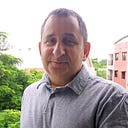Newcomers to quantum computing learn that the states of individual qubits can be represented graphically with Bloch Spheres. And although these unit spheres have x, y, and z axes (called bases), we learn that we can only measure the z basis. Therefore, we can determine the probabilities of measuring a 0 or a 1, giving us the latitude if we think of the sphere as a globe, but we cannot determine the longitude, or the east-west position around the globe.
My workaround draws inspiration from superdense coding and quantum state tomography; my references are listed at the end of this article. In retrospect, the paper should have been sufficient, but I credit the book because credit is due.
Start with any pure state you desire.
If you’re new enough to wonder why I am starting with qubit 2 instead of qubit 0, it’s because the device matters. The specific hardware that I might run this circuit on has qubits arranged in a way in which I could actually start with qubit 0, but this circuit is part of a larger circuit that requires the additional connectivity afforded by qubit 2. You’ll see this measurement circuit again in a separate article after I complete the other part of the full circuit.
